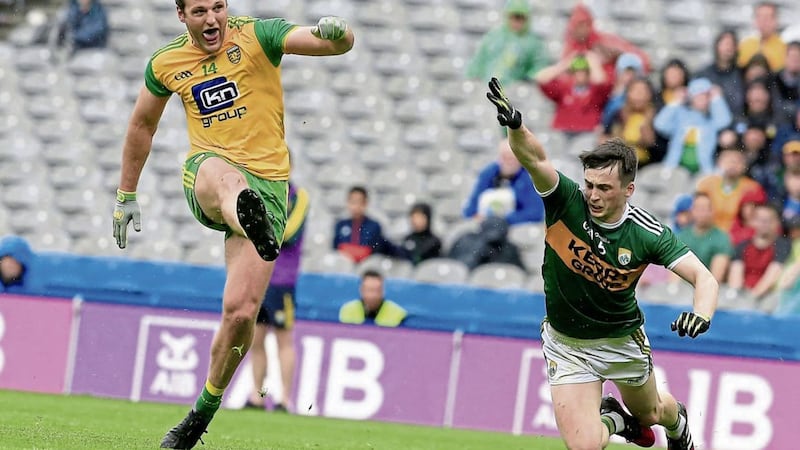WHEN Derry met Kerry in a league final some 16 years ago, the two sides had to wait for the Parnell Park pitch to become vacant.
On a stiflingly hot late-April afternoon, Fermanagh and Wexford were proving as inseparable on the field as they had leaving the field at half-time, when they all got stuck in.
The afternoon produced two classic encounters. Wexford had conceded 2-2 in the opening minutes of the game but went on to win after extra-time.
Derry had endured a similarly tough opening. When Darran O’Sullivan netted the Kingdom’s second goal, they led by seven points. They would lose by four.
For spectators, Parnell Park was perfect. Its compact surroundings held the 13,500 crowd neatly. That was plenty.
For the players, it was a nightmare.
There was nowhere to warm-up. When the Fermanagh game went to extra-time, the Derry and Kerry players found themselves cooped up inside a small changing room, hardly fit to breathe with the heat.
“We’d over 40 guys sitting in one wee room all boiling so they had to go outside and mingle,” said Oak Leaf coach John McCloskey after the game that afternoon.
“You’d the referee changing in the kitchen along with a couple of boys getting physiotherapy treatment. That’s a scandal and yet they’re expected to go out there and perform to win a national title.”
When the same two teams ended up back in the final twelve months later, it was moved to Croke Park.
The whole experience was wildly different.
There were 20,547 people down the Jones’ Road that day, comfortably more than in Parnell Park, yet the atmosphere was understandably muted in an amphitheatre built to hold four times that number.
The league’s roll of honour contains clues over its growth in importance.
Of Kerry’s 23 National League titles in history, seven of them have come since 2004.
Six of Dublin’s 14, almost half, were won between 2013 and 2021.
Teams place greater importance on Division One status than at any time in history.
As the competition has gone in one direction, its showpiece occasion has gone the other.
Recent finals have attracted really healthy crowds.
There were 45,041 in Croke Park last year.
The 2019 final attracted 44,257 people.
It was 53,840 in 2017.
The year previous, the GAA ran its Laochra celebrations to mark the 100th anniversary of the Easter Rising. They got their dream ticket with a Dublin-Kerry final. For the first time ever, the place was sold out for a league game.
Yet the games have been absent of that real break-neck desire to win.
Mayo have been in the last three non-Covid finals and are sick looking at them.
Defeat to Derry at the weekend means they have no chance of reaching another decider, and they could not be happier about that.
Do we make too much out of it all though?
Part of the reason teams aren’t mad to be in a league final is because of its psychological profile.
You have to get up for a league final and then do that again a week or two later for your championship opener.
In Division One, teams are up every week. It’s part of the professional condition that inhabits inter-county changing rooms now, that ability to treat every game the same on an emotional level.
But mostly, it’s a physical thing. Not too many teams really want the extra game.
There were no football matches last week due to a break. No county in Ireland would have treated that as a break.
Week one of that two-week cycle would have involved some of the toughest physical work they’ll have done all year.
Derry look to be the exception. They do want it.
Mickey Harte will know well the significance of Tyrone’s league titles in 2002 and ‘03 on their All-Ireland successes in the years that followed.
Those of Oak hues often point to the last-minute fluke goal from Anthony Tohill in ‘92 that saw them beat Tyrone to claim a first League title since 1947. A year later, Derry were All-Ireland champions.
Every one of the top group of teams has, at some point in recent years, chased a league title.
Even Kerry, whose 2017 win over Dublin had far greater weight attached to it than any league title in their history, even if it didn’t ultimately help them achieve their goal for another five years.
But the split season has made everyone just step off the gas and brush the brakes a bit.
Whether Mayo and Galway reaching last year’s final and both being out of the All-Ireland by the quarter-final stage was coincidence or not, it has left the rest a bit spooked by the fear of it happening to them.
Maybe it’s a kink that will iron itself out but it feels more like a double-knot.
Removing the league finals from the equation might loosen it. It might not.
There have been moves made to get rid of them in the last two years. The GPA pushed against it in 2022.
It came back up last year on Central Coucil’s agenda but quietly went away again.
Financially, the game still makes a whole lot of sense.
But as a sporting entity, it does not.
Every team wants to win the league, just not enough to want to play a final a fortnight before championship any more.
League finals have been a good idea forever, they’ve worked well for almost all of the GAA’s history.
They don’t work well any more. They do more harm to the competition than the financial good is worth.
Top team wins is the only way from here.




